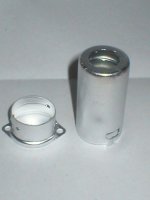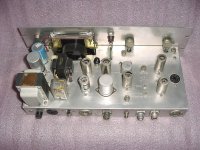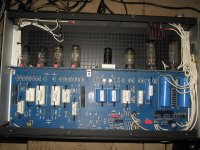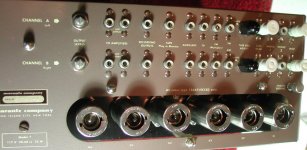I use them sometimes depending on the application. They help reduce noise and hum in very low level stages that are not otherwise shielded. Pictured is a record/playback electronics I built for one of my Ampex recorders. The argument could be made that a shield will add a tiny bit of capacitance to the tube. But it's so minute that the benefit of reduced pickup far outweighs any minuscule change. At least in audio.
Attachments
I use them sometimes depending on the application. They help reduce noise and hum in very low level stages that are not otherwise shielded. Pictured is a record/playback electronics I built for one of my Ampex recorders. The argument could be made that a shield will add a tiny bit of capacitance to the tube. But it's so minute that the benefit of reduced pickup far outweighs any minuscule change. At least in audio.
So, they would be beneficial for a tube pre-preamlifier.
I just wonder if the can should be connected to grounding of the chassis?
They have a great big spring inside, which could help damp microphonics.
They can be bolted to the chassis, so will be earthed.
They can be bolted to the chassis, so will be earthed.
That is the worst kind of screening can, because it restricts the airflow and is a reflector, sending radiant heat back into the tube. At the very least screening cans should be painted matt black, inside and out. Even if painted, use this type only on small-signal valves.
This kind only really provide electrostatic screening. If there is no problem with hum, leave them off. Even if there is, it may be magnetically induced, in which case they will make no difference (to the hum).
This kind only really provide electrostatic screening. If there is no problem with hum, leave them off. Even if there is, it may be magnetically induced, in which case they will make no difference (to the hum).
Am slightly curious about the heat thing. Aluminium is a great heat conductor, and wondered if the heat sinking benefits (conduction, surface area and being bolted to chassis) outweigh the down sides (reflecting radiated heat) and also whether either way matters in an SS triode that much.That is the worst kind of screening can, because it restricts the airflow and is a reflector, sending radiant heat back into the tube. At the very least screening cans should be painted matt black, inside and out. Even if painted, use this type only on small-signal valves.
This kind only really provide electrostatic screening. If there is no problem with hum, leave them off. Even if there is, it may be magnetically induced, in which case they will make no difference (to the hum).
Also, if open at bottom through a doughnut type socket or vents at the lower sides, the heat of the valve may funnel air quite efficiently through the can and increase flow.
Last edited:
There are better types available. Have a look in Morgan Jones' Building Valve Amplifiers for pics. Of this type he says it is 'an abomination and deserves to be crushed'.
Heat is a killer for tubes, it has a major affect on longevity. You can get heatsinks, and screening cans, which are specifically designed to assist cooling.
Heat is a killer for tubes, it has a major affect on longevity. You can get heatsinks, and screening cans, which are specifically designed to assist cooling.
This style of push-on tube shield has been used successfully by industry and the military for many decades. They are meant for small signal tubes that do not generate the high heat that power tubes do. They serve to both shield the tube from external interference and keep the tube seated in it's socket. No one, but no one, puts them on power tubes because they are simply not needed. In fact this style, while they come in three heights, will not fit on most taller 9-pin power tubes. And if a power tube should need this type of hold down shield, there is a vented version with openings in the side. I'd post a picture but mine are packed away somewhere. MJ has a right to his colorful opinions, but he is not the final word.
Thank you for all inputs...
Do you think EAT Tube Dampers provide shielding?
And, maybe a dumb question but how can you say that a tube is shielded?
Do you think EAT Tube Dampers provide shielding?
An externally hosted image should be here but it was not working when we last tested it.
And, maybe a dumb question but how can you say that a tube is shielded?
As a rule of thumb, if it is surrounded by a conductor which is earthed.. The conductor may have holes in it.And, maybe a dumb question but how can you say that a tube is shielded?
So, they would be beneficial for a tube pre-preamlifier.
If the preamp is built inside a metal case, the shields will gain you nearly nothing.
I guess it could help from hum radiated by an AC heater circuit, or from AC parts of PSU that are in case.If the preamp is built inside a metal case, the shields will gain you nearly nothing.
By the way OP you sometimes see signal transformers within a shielded case.
An externally hosted image should be here but it was not working when we last tested it.
I guess it could help from hum radiated by an AC heater circuit, or from AC parts of PSU that are in case.
No, not so much, unless it's a multilayer mu metal shield. The main purpose of the thin metal shields was electrical fields, not magnetic, and typically high frequencies (e.g., RF, which is why they're common in receivers).
The best way to avoid hum pickup from within the case is to do the layout competently. If you do an incompetent layout, the shields aren't going to help you.
They're used in most guitar amplifier in the preamp section , really needed in HI-gain stages to reduce microfonic effect , hum especially when tubes are close to main transformer and on some design if you take away the shield amp starts squealing !
Rarely seen on HiFi amps maybe cause they aren't so cool looking 😀
Black is better for heating factor.
Rarely seen on HiFi amps maybe cause they aren't so cool looking 😀
Black is better for heating factor.
If the preamp is built inside a metal case, the shields will gain you nearly nothing.
Could you explain this please? 🙂
You can see my unit. It is a tube pre-pre amplifier for MC inputs. It is all metal case and transformer is not in that chassis. I'm thinking to use screening cans on the four 7308 tubes at the left. I'm considering Telefunken or Amperex USN-CEP tubes which I don't know if they are shielded or not.
Attachments
You're trying to screen against external electrical fields. The case does that already, assuming it's metal. Google "Faraday cage"- basically, that's what your case already is.
There was once a brand of tube shields (IERC) that advertised a longer tube life, by reducing temperature. They were flat black and had multiple conductive fingers on the inside. You still see them sometimes on old mil surplus or amateur radio gear. I think the theory goes that their larger (thermal) radiating surface keeps anode temperature down, but I'm not certain how important that might be for your average 12AX7.
If I could find any for EL84/6BQ5 size tubes, I'd sure give them a try. (Yes, they were once made in that size. But all mine are smaller.) And they were non-magnetic, so not a mag field shield.
The interesting question to me is whether a steel shield painted black would raise or lower anode temperature, given a room temperature background.
Thanks,
Chris
If I could find any for EL84/6BQ5 size tubes, I'd sure give them a try. (Yes, they were once made in that size. But all mine are smaller.) And they were non-magnetic, so not a mag field shield.
The interesting question to me is whether a steel shield painted black would raise or lower anode temperature, given a room temperature background.
Thanks,
Chris
There are better types available. Have a look in Morgan Jones' Building Valve Amplifiers for pics. Of this type he says it is 'an abomination and deserves to be crushed'.
Heat is a killer for tubes, it has a major affect on longevity. You can get heatsinks, and screening cans, which are specifically designed to assist cooling.
Similar tube shields were used by millions in consumer,commercial,military and pro equipment in the good old days and were very effective against hum in low level high gain stages. Tube overheating and/or reduced life were not reported and never an issue as far as I know, such shields being not used on power tubes where heat dissipation is an important factor.
Poorly designed unreliable lousy equipment made by MARANTZ, MAC INTOSH , FISHER,etc... used them too.
Of course if an Audio Guru now claims they must be crushed, then you may follow his advice and crush them... but don't complain about hum pickup in your preamp.
Attachments
Or don't mount your tubes on the outside. Note that Firo has his tubes mounted on the inside of the cabinet. The tube shields accomplish close to zero.
If the preamp is built inside a metal case, the shields will gain you nearly nothing.
This is only true as long as there are no power transformer or other AC radiating components inside the preamp case. (external power supply)
The original AMPEX (351) tape preamp quoted above is in a fully enclosed metal case but use tube shields to help reduce hum pickup from the internal power transformer and AC carrying wires.
- Status
- Not open for further replies.
- Home
- Amplifiers
- Tubes / Valves
- Tube Screening Cans



